According to statistics from the China Automobile Association, the output of new energy vehicles in January-April 2016 was 94,442 units, an increase of 126.8% over the same period of the previous year. The power battery as the core component also follows the overall market trend of new energy vehicles, showing a high growth trend. According to the data of the First Electric Research Institute, the power battery shipments reached 3.42Gwh in the first four months of 2016, which was 2.38 times higher than the 1.06wh shipments in the same period last year. (Note: The following power battery data is derived from the product of the new energy vehicle output and the battery capacity it carries. The overall actual production capacity will be slightly higher than this because no other influencing factors are considered. The battery shipment calculation formula: model battery capacity* model production .)

According to different materials, the existing power battery can be roughly divided into lithium iron phosphate battery, ternary lithium battery, lithium manganate, nickel hydrogen battery, lithium titanate and the like. Among them, although lithium iron phosphate is still the mainstream battery type in the market, its growth rate is less than that of ternary lithium battery. According to the data of the First Electric Research Institute, the shipment of lithium iron phosphate battery reached 2.6Gwh in the first four months of 2016, accounting for 75% of the total, which was more than double the growth of the same period last year. The shipment of ternary material batteries is less than 1Gwh, accounting for 23%, but an increase of 3.47 times compared with the same period last year. Secondly, lithium manganate battery is only 50.8Mwh, accounting for only 1%; including nickel-hydrogen, far-reaching, lithium titanate battery and other battery materials, the cumulative shipments also reached 22.86Mwh, accounting for 1%.
In terms of models, the battery capacity of passenger cars and commercial vehicles is basically balanced. Among them, the pure electric bus has a battery capacity of 1.53Gwh, accounting for 45%; the pure electric passenger car has a battery capacity of 1.41Gwh, accounting for 41%; the plug-in passenger car has only 0.27Gwh, accounting for 8%. The plug-in bus battery capacity is 0.09Gwh, accounting for 2%; the pure electric special vehicle is 0.13Gwh, accounting for 4%.

At present, the battery types are mainly lithium iron phosphate and ternary materials, and the cumulative shipments of the two are 3.34 Gwh, accounting for 97.66% of the total. Comparing the application fields of the two battery materials, the two are distributed in the passenger car, passenger car and special vehicle fields, but the lithium iron phosphate battery is mainly used in the passenger car and passenger car fields, and the distribution of the two parts of the battery is 1.5Gwh and 1Gwh, both exceeding 1Gwh, accounting for 97% of the total lithium iron phosphate battery (2.57Gwh); and the ternary material battery is subject to the government's previous suspension of the ternary lithium battery bus included in the new energy vehicle promotion application recommended model catalogue This type of battery is mainly concentrated in the field of passenger cars.
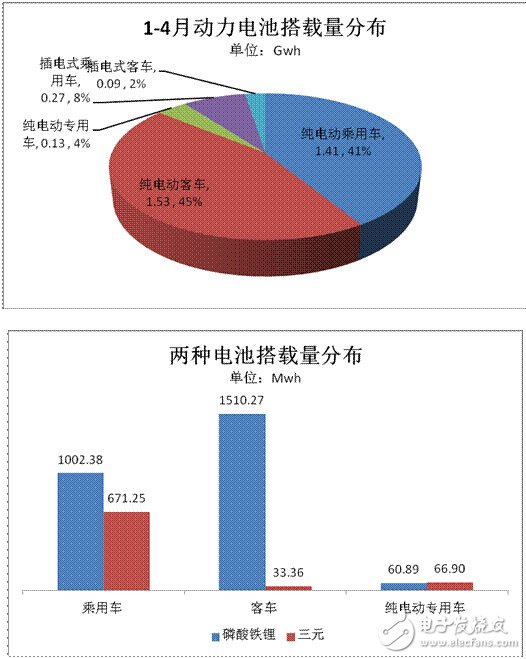
In terms of subdivision, the ternary battery capacity of the passenger vehicle field reached 671Mwh this year, accounting for 87% of the total (0.77Gwh); secondly, the ternary battery shipment in the special vehicle field reached 66.9Mwh. The proportion is also 9%. Finally, it is worth noting that the proportion of ternary lithium batteries in the passenger car area is also 4%, and the corresponding battery capacity is 33.36Mwh, among which the bus companies are mainly distributed in Nanjing Jinlong, Zhongtong, Xiamen Golden Brigade and Chongqing Hengtong. Below the pure electric bus model.
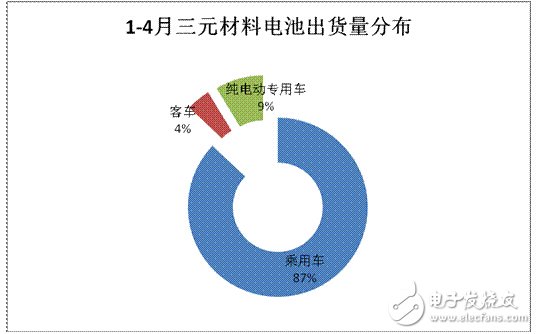
In terms of ternary lithium batteries, the previous policy required to suspend the use of ternary lithium batteries in the passenger car sector. However, compared with the shipment data for the same period last year, this has not had much impact on the total capacity of ternary lithium batteries, and 2015 - In April, the shipment of ternary lithium battery (172.55Mwh) was compared with this year, which achieved a 3.47 times year-on-year increase, with a net increase of 600Mwh. In terms of subdivision, the change of ternary lithium battery in the passenger car field is basically not up, only about 21Mwh; the corresponding increase in production capacity in the passenger car field is the most obvious, with a year-on-year increase of 3.44 times, net increase of 520Mwh; second, three The changes in the field of special-purpose vehicles in the field of special-purpose vehicles have also gradually increased with the trend of the production of special-purpose vehicles. The increase in battery carrying capacity has reached 57 Mwh, an increase of 5.7 times.
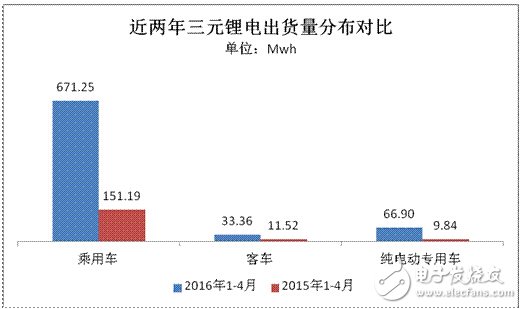
According to the subdivided power battery manufacturers, the number of manufacturers with battery output in the first four months was nearly 90. Among them, the top 10 manufacturers had a total battery shipment of 2.63 Gwh, accounting for 77%; and the shipment exceeded 100 Mwh. The number of manufacturers is only 7: BYD, CATL, Guoxuan Hi-Tech, Shenzhen Topang, Lishen, Pride, and Guoneng. The total battery shipments of the seven batteries reached 2.4Gwh, accounting for 70%.
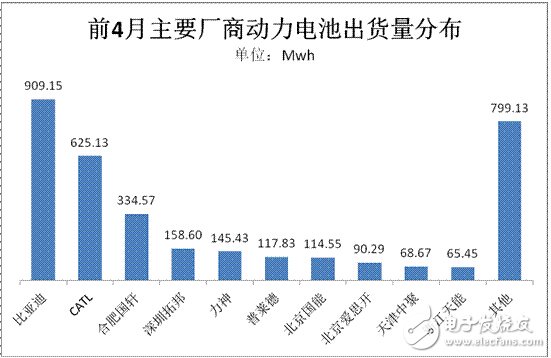
Among them, BYD still continued its position as the first place last year. The self-produced lithium iron phosphate battery reached 909Mwh, accounting for nearly 27% of total power battery shipments; the second-ranked CATL shipments were as high as 625Mwh, accounting for 18%. Mainly based on lithium iron phosphate, ternary batteries are also involved. Among them, CATL's planned power battery capacity is twice that of 2015, and it plans to account for 20% of the overall planned production capacity in passenger cars, and it continues to be distributed last year, mainly based on passenger cars.
Secondly, Guoxuan Hi-Tech power battery shipments reached 334.6Mwh, accounting for 10%, and its battery type is basically lithium iron phosphate battery, mainly for passenger cars enterprises such as Zhongtong and Ankai, and also has Jianghuai in the field of passenger cars and special vehicles. SAIC Chase and other companies. The shipments of Shenzhen Topang, Lishen and Pride batteries were 158.6Mwh, 145.4Mwh and 117.8Mwh, respectively, accounting for 3%.
| About EIW/A Enameled Copper Wire |
Polyimide enameled round copper wire,class 220
According to the design of automotive electrical characteristics, the breakdown voltage is 60% higher than the national standard, and the adhesion is 20% higher than the national standard.
Thermal shock temperature increased by 20℃ compared with the national standard. With solvent resistance, good flexibility, high surface strength, suitable for automatic mechanical winding, embedding.
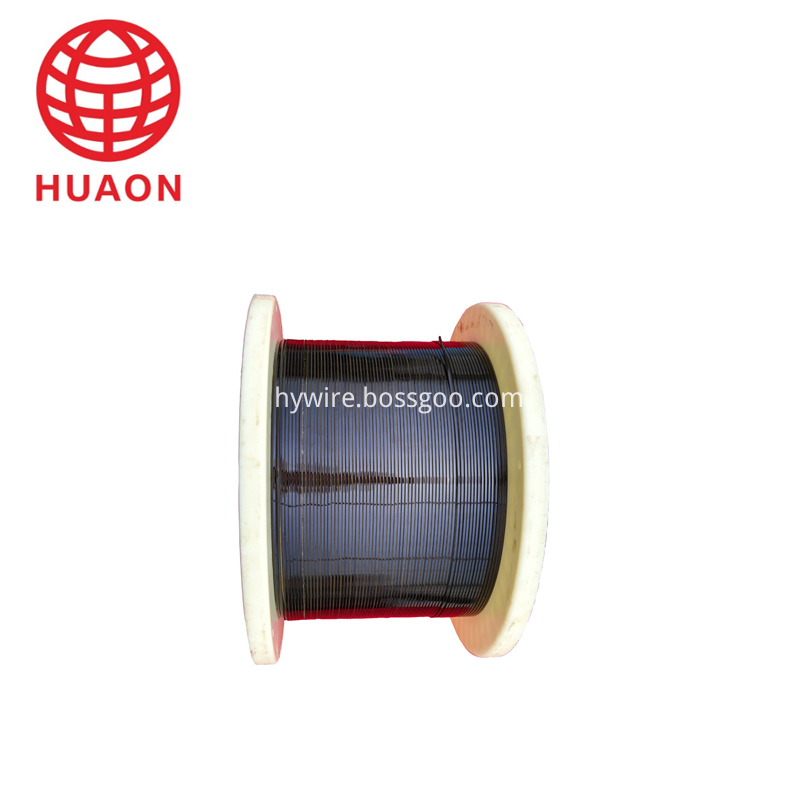
|
Package of Products |
||
| Size Range φ(mm) | Spool | Pallet capacity |
| 3.30-5.00 | P N 500 |
6 spools / 720 kg |
| 1.30-3.20 | PT 200 |
4 spools / 800 kg |
| 0.51-0.96 | PT 90 |
9 spools / 810 kg |
| 0.31-0.50 | PT 25 |
50 spools /1250 kg |
EIW/A Enameled Copper Wire
Stranded Copper Wire,Eiw/A Enameled Copper Wire,Magnet Enameled Aluminum Wire,Enameled Aluminum Wire For Rotor
HENAN HUAYANG ELECTRICAL TECHNOLOGY GROUP CO.,LTD , https://www.huaonwire.com